#horakhety
Explore tagged Tumblr posts
Text

Heruakhety (Horakhty) is an Egyptian god whose name means "Horus of the Horizons." He is thus associated with the sun's crossings made each morning and evening. Horus is a particularly complex deity; he appears under a number of names and in a number of guises, most notably Horus the Elder (Heru-wer) and Horus the Younger (Heru-sa-Aset) but he has other significant aspects as well, including the form of Heruakhety. He was later associated with Ra and known as Ra-Heruakhety. Like Ra, he had a particular center of worship in the city of Heliopolis. He is depicted here as a man with the head of a hawk, wearing the solar disk with uraeus snake and the double crown (pschent) of Upper and Lower Egypt. He carries the was staff, a symbol of power, in one hand and the ankh, a symbol of life, in the other.
Heruakhety who crosses the sky with incense, great god of the horizon, I praise and honor you.
5 notes
·
View notes
Text




Horus 𓄿 Talon Abraxas
Horus (Also Heru-sa-Aset, Hrw, Hr, and Hor-Hekenu) is the falcon-headed god of ancient Egyptian mythology.
Like many other gods the nature of what he was and the legends and stories that went with him changed over the course of history. Horus was an amalgamation of other, related deities, all of whom were sun gods and associated with the royal prerogative and the sky. Because Horus was a combination of other gods, it is rarely correct to refer to "Horus" as Horus was as much a family of related deities (though many had differing parentages) unified in one being; something similar occurs in many Christians' interpretation of the one God who manifests in three parts.
Heru-ur (also called Harmerti) is the oldest version of Horus, and was a falcon creator-god who was known for restraining Apep. His eyes were the sun and the moon; during a new moon, he was blind and was called Mekhenty-er-irty ("he who has no eyes") and upon the return of his sight, he was called Khenty-irty ("he who has eyes"). While blind, Horus was quite dangerous, sometimes attacking his friends after mistaking them for enemies. He was a son of Geb and Nut and was the patron god of Letopolis.
As a child, Horus was called Har-pa-khered ("Horus the child" and called Harpocrates by the Greeks) and was a son of either Osiris and Isis or Banebdjetet and Hatmehit. He was depicted as a naked boy with a finger in his mouth, sitting on a lotus with his mother. In this form, he was a fertility god and was depicted with a cornucopia. Har-pa-Khered became very popular during the time of the Roman Empire, when he was depicted riding a goose or ram (note Banebdjetet, his father, was a ram god).
Later Horus became absolutely aligned as a son of the dead body of Osiris and Isis (alternatively: he emerged from Saosis' acacia tree). This is very often cited as "the" Horus in many scholarly works. In truth, this Horus was called Har-sa-iset or Harsiesis.
As Har-nedj-itef (Harendotes in Greek), Horus was Osiris' bodyguard in the underworld, called the Duat.
As Behedti, Horus was the patron deity of Behdet (cur: Edfu), where he was strongly associated with the falcon.
As Chenti-irti, Horus was a falcon-god of law and order.
Later still he became associated with the sun god Ra where they combined especially at Heliopolis and became Ra-Herekhty (also Ra-Heru-akhety, Her-akhety ("Horus of the two horizons"), Har-em-akhet ("Horus upon the horizon"), Horakhety, Harmachis (Greek)), god of the morning sun.
Anhur was Horus as a union with Shu.
In the 3rd millennium BC, Set became the patron god of the pharaohs (replacing Horus in the form of Har-mau or Harsomtus) after overthrowing Horus in the form of Har-wer or Haroeris. Later a story became popular that Set had killed Horus' father Osiris, and Set was thought of more and more as an evil god. So Har-mau was again made the pharaohs' patron in this myth: A war between Set and Horus ensued, lasting for eighty years. Har-mau tore off one leg and the testicles of Set, who in turn took out Har-mau's left eye (hence he is referred to as "the one-eyed god"). His eye was later returned to him. Horus won the war (with the support of Neith) and became the ruler of Lower and Upper Egypt. Seth was castrated or killed or moved in with Ra and became the voice of thunder.
Horus was the father of the four gods associated with the canopic jars of Egyptian funerary beliefs: Imset, Hapi, Duamutef, and Kebechsenef.
50 notes
·
View notes
Text
Prayer to Djehuty for Artistic Inspiration
Hail and praise onto you, Djehuty, True Scribe of Ma'at!
Oh, Thrice Great of Heka Power, Wise One in Iunu, the Mousa has fled, she prowls a distant land in the form of a lioness!
Bring her back to me, place her on my brow, for I am her father, Ra Horakhety, and I am in need of her.
Render this service to me and I shall make offerings to you on the festivals of the month, the sixth day, the half-month, and all the other festivals appropriate to you, Oh Reckoner of Months, of Days, of Hours.
Bring her to me and you shall receive a thousand loaves of bread, a thousand jugs of beer, a thousand cuts of beef and fowl, and all other things good and pure on which a god lives.
#sharing an originally written prayer in case anyone finds it useful#this is a first experiment in Graeco-Egyptian syncretism#equating the solar eye to The Muses and referencing the distant goddess myth#I specifically call upon Djehuty because I'm a writer#but I think it works well for just general purpose artistic inspiration due to the mythic context#I guess if you're a musician Hathor may work just as well#so that's an option if you want this prayer to be purely Kemetic#kemeticism#djehuty#hellenism#mousai
78 notes
·
View notes
Text
I Templi di Abu Simbel
I templi di Abu Simbel furono costruiti da Ramses II nel remoto villaggio di Abu Simbel, che si trova a distanza di 280 km a sud di Assuan, furono tagliati dalle montagne di roccia arenaria ad Abu Simbel e progettati per affacciarsi sul Nilo. I due Templi di Abu Simbel, quello grande e quello piccolo sono stati successivamente spostati in un'altra altura dall'UNESCO nel 1964, operazione che si è conclusa nel 1968. Ciò era dovuto all'aumento del livello del fiume Nilo che ha portato all'allagamento dei templi.
I Grandi Templi di Abu Simbel sono anche conosciuti come il tempio meridionale e il tempio di Ra-Horakhty perché si trova a sud del piccolo tempio ed era dedicato al dio Ra-Horakhety. Per quanto riguarda il piccolo tempio era anche conosciuto come il tempio meridionale e il tempio di Hathor, la signora di Ebshek, la regione di Ebshek si trova a sud di Abu Simbel in Sudan.
La facciata del grande tempio è di circa 38 m di larghezza e 33 m di altezza, è decorata da quattro statue colossali di 20 m che raffigurano il Re , due su entrambi i lati dell'ingresso. Piccole statue della sua famiglia sono tagliate tra le sue gambe, la parte superiore della facciata è decorata da una cornice a cavetto recante i cartigli del re, sopra la cornice c'è una fila di statue di babbuini adoranti il sole, sotto la cornice c'è la fila di iscrizioni che danno i nomi e titoli del re, l'ingresso al il tempio è tagliato al centro della facciata tra le 4 statue sopra l'ingresso c'è una rientranza decorata da una rappresentazione del dio Ra-Horakhty.
La prima sala ipostila, l'ingresso conduce alla sala ipostila che è lunga 20 m per 18 m di larghezza, all'interno della sala, ci sono otto sculture del Re nella Posa Osiriaca allineate quattro a quattro contro 8 pilastri quadrati nella sala ipostila. Le scene di questa sala principalmente rappresentano scene della battaglia di Kadesh e scene di offerte tradizionali del re che fa un'offerta davanti a diversi dei per ottenere la loro benedizione.
La seconda sala ipostila, più in profondità nella roccia è un'altra sala con pilastri che misura 11 * 12 m, contiene 4 pilastri su entrambi i lati, le scene qui rappresentano principalmente il re e sua moglie Nefertari, all'estremità occidentale di questa seconda sala ipostila, sono 3 le porte che conducono al vestibolo che a sua volta immette al centro del santuario del tempio e ai due piccoli vani laterali non decorati, probabilmente adibiti a deposito.
All'interno del santuario scavato nella roccia ci sono 4 statue che rappresentano Ptah, Amon, Ramses II divinizzato e Ra-Horakhety, al centro della stanza ci sono i resti del piedistallo che probabilmente serviva per collocare la barca sacra.
Il sole splendeva sia sulla facciata che all'interno del grande tempio due volte all'anno, il 22 ottobre che rappresenta il Giorno di Compleanno del Re Ramsis , e il 21 febbraio il giorno della sua incoronazione .
Il piccolo tempio di Abu Simbel, questo tempio di Hathor e Nefertari, è noto come il piccolo tempio e fu costruito da Ramses II circa un centinaio di metri a nord-est del grande tempio, era dedicato alla dea Hathor, la signora di Ebshek, e La principale consorte di Ramses II, Nefertari, era, infatti, la seconda volta nella storia dell'antico Egitto che un tempio era dedicato alla regina ( dopo Hatshepsut).
La facciata del Tempio, la facciata rupestre è di 30 m di larghezza e 13 m di altezza, è scavata nella roccia ad imitazione di un pilone con cornicione a cavetto che ora manca, la facciata è decorata con due gruppi di tre colossi che sono separate da un grande portale le statue sono alte poco più di dieci metri e rappresentano il re e la sua regina, il portale immette in una sala ipostila quadrata divisa in tre navate da sei pilastri, questi sei pilastri sono decorati dalla parte anteriore dalla testa di la dea dalle orecchie di vacca Hathor, sugli altri lati dei pilastri ci sono scene della coppia reale e di varie divinità.
Dalla sala ipostila, tre porte conducono in una stretta camera trasversale, con una scena che mostra la regina che fa offerte di fronte a Hathor, oltre la camera trasversale è il santuario nella parete posteriore del quale è una rientranza a forma di cappella il suo tetto sostenuto da sistro, in questa rientranza è una figura in altorilievo della dea Hathor come una mucca e sotto la sua testa e quindi sotto la sua protezione è la regina.
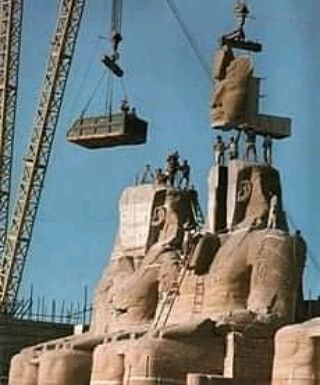

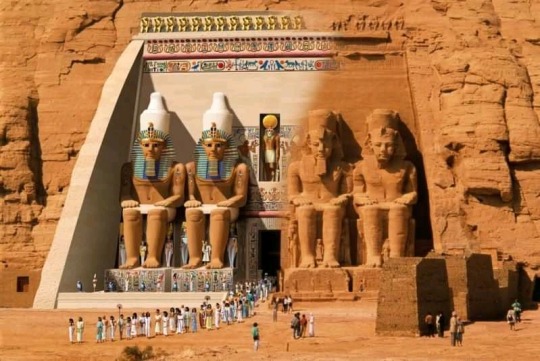
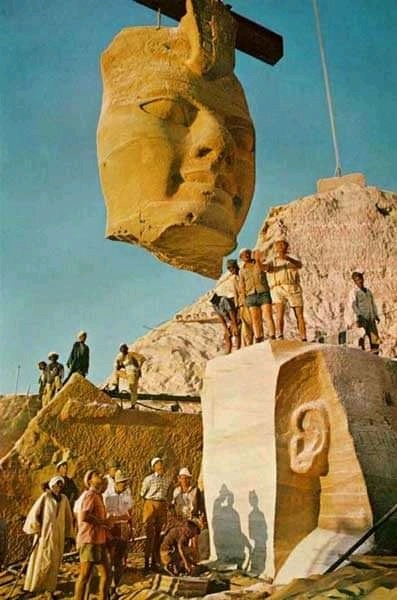
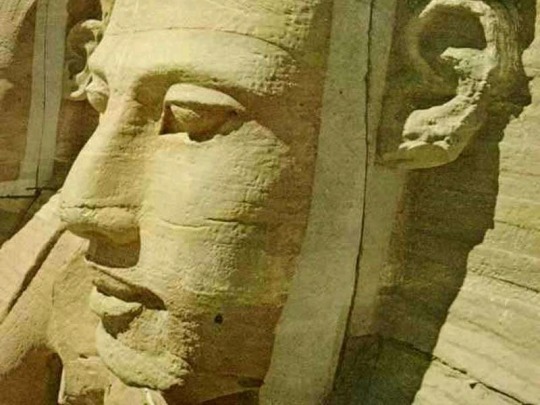
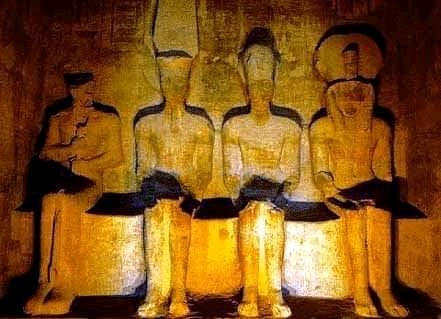



0 notes
Text
Why is the Abu Simbel temple important?
The Temples of Abu Simbel were built by Ramesses II At Abu Simbel, which lies 240Km south of Aswan, they were cut out of the sandstone rock mountains at Abusimbel and designed to overlook the Nile. these temples, the great one and the small one have been later moved to another high location by UNESCO in 1964, an operation that ended in 1968. this was due to the increase in the level of the Nile river which led to the flooding of the temples.
The Great Temples of Abu Simbel is also known as the southern temple and the temple of Ra horakhty because it lies to the south of the small temple and it was dedicated to god Ra Horakhety. As for the small temple it was also known as the southern Temple and the temple of Hathor, the lady of Ebshek, the region of Ebshek lies south of Abusimbel in Sudan.
The Façade of the great temple is about is 38m In width and33m In Height, it is decorated by four 20 m colossal statues of the kings two on either side of the entrance .little statues of his family are cut between his legs, the top of the façade is decorated by a cavetto cornic bearing cartouches of the king, above the cavetto cornice there is a row of baboons statues adoring the sun, under the cavetto cornice there is the line of inscriptions giving the names and titles of the king, the entrance to the temple is cut in the middle of the façade between the 4 statues above the entrance there is a recess decorated by a representation of god Ra horakhty.
Try our amazing Abu Simbel tour from Aswan, Enjoy United Guides Travel abusimbel tours from luxor
for more Details About Abu Simbel
or send your Request :info@unitedguidestravel.com
0 notes